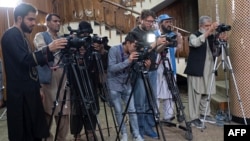Journalists in Afghanistan are forced to navigate an environment of “censorship and tight restrictions” under Taliban rule, the United Nations has said.
From the Taliban takeover on August 15, 2021, to September 30 of this year, the Taliban have detained journalists 256 times and 130 cases of torture and poor treatment have been documented, according to the report published Tuesday by the U.N. Assistance Mission in Afghanistan, or UNAMA.
The report documents the “arbitrary arrests, torture, and violence” that journalists have been subject to since 2021, according to Freshta Hemmati, of the Afghanistan Journalists Support Organization.
“They are working under the severe pressure of censorship and restrictions,” she told VOA.
The Taliban-led foreign ministry said that the figures in the report were “exaggerated” and that journalists are detained only for violations of law, the Reuters news agency reported.
The ministry cited crimes including defaming the government, false or baseless reports, and providing material to media outlets against the system, Reuters reported.
The UNAMA report found that journalists and media workers in Afghanistan often face “unclear rules on what they can and cannot report.” This leads to the high risk of arbitrary detention for what the Taliban deem as criticism.
Analysts who spoke with VOA said that the report reflects the media suppression in Afghanistan and is a hallmark of the Taliban rule.
“The aim of multiplying the arrests is to instill fear in the whole media community and to provoke self-censorship and submission," Célia Mercier, head of Reporters Without Borders’ South Asia Desk, told VOA in an email.
Since the Taliban resumed power, they have imposed a strict interpretation of Islamic law. Their administration has not been officially recognized by any foreign government. Within three months of the takeover, around 40% of Afghan media outlets disappeared, according to the media watchdog group Reporters Without Borders, or RSF.
The takeover led to a large exodus of journalists. Those who remain risk being targeted, according to Beh Lih Yi, of the Committee to Protect Journalists, or CPJ.
CPJ has documented “cruel assaults and beatings” of journalists by Taliban forces. Often, journalists and their families choose to remain silent about a detention for fear of retribution.
“All these repressive measures of the Taliban are aimed at creating a chilling effect on the press and deterring journalists from continuing their reporting,” Beh told VOA in an email.
The restrictions have especially impacted women journalists in Afghanistan, Hemmati, of the Afghanistan Journalists Support Organization, told VOA. After the Taliban takeover, eight in 10 women journalists stopped working, according to RSF data.
The Taliban foreign ministry, in its response to the UNAMA report, said women were free to work if they met conditions, such as covering their faces and working separately from men.
Watchdogs have called on Afghan authorities to uphold press freedom by respecting the country’s media law, ratified nearly a decade ago. This law outlines the right to free expression in the country, with the goal of protecting journalists, according to the Afghanistan Journalists Center.
The UNAMA report called on the Taliban to improve conditions for media.
“We urge the de facto authorities to ensure the safety and security of all journalists and media workers as they carry out their tasks, and to fully recognize the importance of women working in the media sector,” Roza Otunbayeva, special representative of the secretary-general and head of UNAMA, said in the report.
Afghanistan is ranked at No. 178 out of 180 on the Press Freedom Index, where 1 signals the best environment. In 2021, before the Taliban takeover, the country ranked 122nd.
Sahar Azimi of VOA’s Afghan Service contributed to this report.









